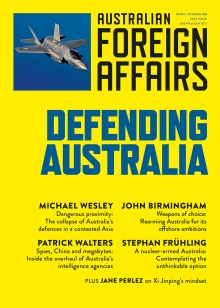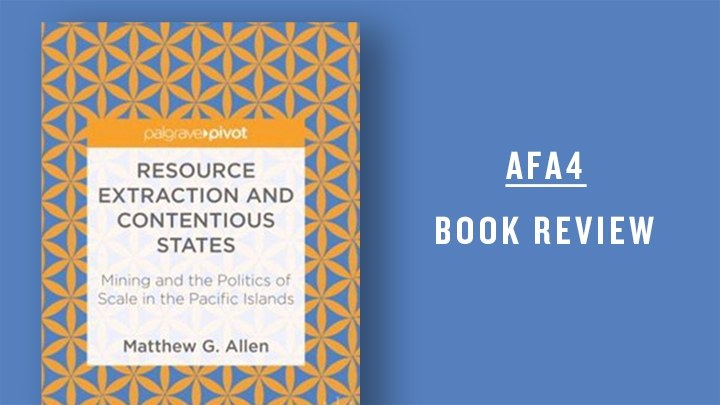
This review is featured in Australian Foreign Affairs 4: Defending Australia.
To read the full issue, log in, subscribe or buy the issue.
Resource Extraction and Contentious States: Mining and the Politics of Scale in the Pacific Islands
Matthew G. Allen
Palgrave Macmillan
It was only when I was about halfway through the first chapter of Matthew Allen’s new book that it hit me – I have only ever lived on an island. The one I’m living on now (Australia) is a very big one, and the one I started on (the United Kingdom) is very crowded. But the one where I spent almost half of my life is Efate, in Vanuatu. And that place certainly felt most like an island to me, with its ring road that takes about two hours to drive all the way around, providing a view of the Pacific Ocean pretty much the whole time.
In Resource Extraction and Contentious States, academic researcher Matthew Allen explores the impact of “islandness” on social, economic, political and cultural contexts, though he acknowledges that geography is not determinative. His research is focused on a particular form of economic development – mining – that takes place in specific locations in Solomon Islands (Gold Ridge mine, which operated between 1998 and 2000, and between 2010 and 2014), Bougainville (Panguna mine, 1972 to 1989) and “mainland Papua New Guinea” (various ongoing projects, including Lihir mine, which opened in 1997). However, the issues he identifies apply to almost any form of development in Pacific island countries. In this region, any project that requires a shift from traditional systems of governance to legislation, or that prioritises the cash economy over networks of reciprocity and mutual obligation, risks becoming a flashpoint for competition, dispute and, in extreme cases, conflict.
A discussion of development in Melanesia, especially in rural and remote areas, begins and ends with land. Allen provides countless illustrations of the importance of land as a source of cultural and ethnic identity, as a focus for political negotiation (and often intrigue), as the bedrock of rural livelihoods and as a potential trigger for tension, disagreement and aggression.
With the exception of Fiji, Pacific island populations are rural, not urban. This is changing, but will remain the case for some time, particularly in Melanesia. Often, rural populations live according to what might be described as a “subsistence plus” economy. Much of what they need can be obtained from their environment, including materials from the rainforest to build houses. In some cases people are able to generate a small surplus of food to sell. This provides cash to purchase items such as fuel, medicines or credit for mobile phones.
In many Pacific island countries the state is largely absent from the everyday lives of its citizens. Allen makes frequent reference to the lack of state services and infrastructure in remote and rural areas, such as Guadalcanal’s Weather Coast in Solomon Islands. Traditional systems of decision-making, resource sharing and dispute resolution are central to how rural communities operate. In addition, there is a social safety net in the fact that people have land on which to build and to grow food.
Pacific islanders also mostly live on land that is held according to custom. How that custom operates differs from country to country and, especially in Melanesia, from place to place. Much of it is not written down and is highly complex.
Into this intricate and delicate socio-political environment comes something as disruptive as a major mining project – and the potential for discord becomes significant.
Allen details a telling example: the impacts of the Gold Ridge mine on kastom (traditional governance systems) on the island of Guadalcanal. The expectations of investors and the state, as documented in contracts and legislation, did not marry up with long-established systems of “social organisation, decision-making and land tenure” within the community. Attempts to bridge these differing expectations included the creation of “landowner associations” and the establishment of a “land trustee system”. However, this led to tribal groups fracturing as individuals felt marginalised by decisions made by the associations. The payment and distribution of royalties and mine-related lease payments were subject to the control of gatekeepers – predominantly senior men. All of this contributed to tensions within family and kinship groups and an erosion of kastom more generally.
Allen identifies a number of ways in which the redistribution of benefits (or lack thereof) can provoke conflict or throw fuel on a fire of long-running jealousies, tensions and disputes. Drawing on the work of Anthony Regan, Allen shows how the impacts of the Panguna mine in Bougainville exacerbated the existing “relative deprivation”. Essentially, the people who benefited most from the mining project were already doing well out of cocoa. Those who had not been able to generate a good income from cocoa – often owing to factors outside of their control – were less able to access the opportunities the Panguna mine presented and more vulnerable to the adverse social impacts that followed its development.
This situation reflects a perennial challenge that faces governments in Melanesia: how to balance the demands of landowners so that they get the benefits of development that exploits “their” resources (or uses their land to access those resources) with the need to redistribute the benefits to the rest of the population (whether of that island or across the country). The tensions that Allen focuses on in these mining projects also affect activities that appear a lot less controversial. In Vanuatu, for example, the economic impacts of cruise-ship tourism are significant in the locations where port calls are made. This leads other communities to lobby strongly to be included in the itinerary. Policymakers have to navigate a complex environment where the potential for dispute is constant.
One of the most appealing aspects of Allen’s study is his consideration of exclusivity in resource exploitation in Bougainville and Solomon Islands. He notes that women are generally excluded from decision-making in relation to land issues. When it comes to distribution of benefits, they are at the end of the line, as mere recipients. Allen also considers the impacts of exclusion on young people and notes the role that disenfranchised young males have played in situations where conflicts have arisen. There are indications that these young men are more than just foot soldiers in armed conflicts, but view critical junctures such as the Bougainville crisis as a means of forcibly removing an ageing leadership that is reluctant to cede power and authority in any sphere.
Again, this motif resonates throughout the Pacific island region. Vanuatu-based journalists Kiery Manasseh and Dan McGarry note in an article, “New Parties for the Old” (2013), that one of the contributing factors in the fracturing of Vanuatu’s political parties through the 1990s and early to mid 2000s was a frustration among “young Turks” with the older generation’s inability and/or refusal to move on from positions of leadership.
Allen’s book, and his exploration of recent contentious mining projects within a paradigm of “islandness”, is timely. As we approach the referendum on independence in New Caledonia (where nickel mining is a significant part of the economy) and in Bougainville (where the debate over whether Panguna should be reopened seems far from settled), concerns about the potential for mining projects to spark conflict are very much on local – and international – agendas. In addition, a number of Pacific island countries are contemplating a move to deep-sea mining as a way of growing their economies, which is likely to introduce a new set of unknowns. This book offers many insights that we hope can inform policymakers, investors and communities in negotiating future mining projects in the Pacific island region.
Tess Newton Cain







